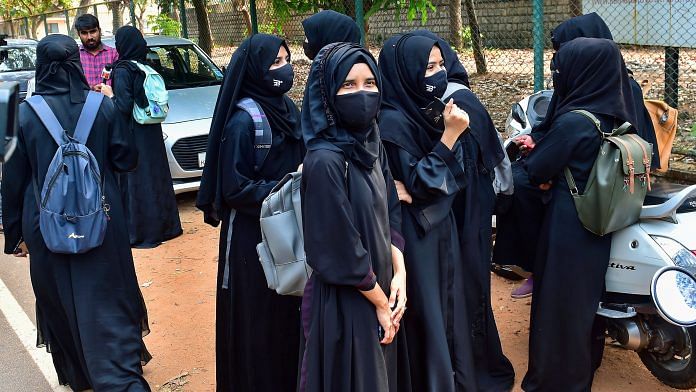The Karnataka hijab controversy exemplifies a vicious and protracted battle between male-centric religious nationalisms and Muslim women’s bodies across regions. Re-hijabing and jilbabing defined the violent phase of Taliban rule in Afghanistan in the 1980s and the Islamic Republic of Iran under Ayatollah Khomeini, whereas de-hijabing—the tearing of women’s sartorial markings—became a major political act in Iran under Reza Shah in the early 1920s.
Even though thousands of Muslim women challenged Iran’s imposition of hijab in 1979, all of them were put down by doctrine and punishment. In the late 1970s, Muslim women in Tehran were broadly divided into three categories: non-hijabi, “bad hijabi,” and good hijabi, with only the latter being allowed to enter the theocratic state’s moral template. When it comes to open threats against hijab-wearing women in Karnataka, only non-hijabi Muslim subjects are considered as the uncontested Muslim subjects under Hindutva rule in the state. All of these examples convey the same story: Muslim women’s bodies are still a site of political and ideological contestation in the modern world.
When one considers the recent street protests in India that began with Shaheen Bagh in Delhi where a huge number of Muslim women were active participants, it is clear that they are no longer satisfied with being mere bearers of community symbols and Islamic principles. Despite this, the liberal intelligentsia, which is still locked in the out-of-dated category of “Islamic/Muslim backwardness,” has disregarded their resurrected consciousness as agents of resistance and collective secular resilience. Along with the multiple mobilities in the past two decades, educated Muslim women’s increasing familiarity with hijab discourses in contested cultural and ethnic sites across the world also played a crucial role in making them believe in themselves as agents of change, of self and others.
Also read: Why Shaktikanta Das’ lack of formal education in economics is a gift for India
However, their sartorial assertion can only be fully explained along with the shifts in the Indian social and political landscape in the last few years. This period has witnessed a “great divide” in various interactive spaces. Muslim women’s insistence on a new sartorial identity, thus, cannot also be removed from the new interactional, emotional, material and political circumstances that emerged out of this “great divide.” Living consciously in the everydayness of an alienating cultural hegemony that pushes them away through subterfuge, the headscarf is turning out to be a conduit for solidarity, kinship, and selfcare in India’s shrinking public spaces. Amina Wadud, the eminent Muslim feminist scholar who challenged the male centric interpretation of Islam, identified a reverse sartorial shift when Muslim women became the target of ‘white American radicalism’ after the attack on the World Trade Center.
Muslim Women were forced to hide their hijab, and their Muslim identity, and Wadud sees such forced acts as the ‘erasure of being Muslim.’ A rising number of progressives and a section of the Muslim intelligentsia agree that the headscarf may be used to voice effective dissent in the increasingly Islamophobic world, while another continues to make hard criticism of the tradition of veiling (Niqab) and covering (Purdah). For the former, sartorial assertion has become the most effective and non-violent conduit of dissent and subversion in the wake of the all-encompassing cultural nationalisms across the world. Therefore, the focal point of the girls in scarves in Karnataka or elsewhere needs to be transferred from the framework of ‘right to education’ to a more appropriate theoretical premise- the ‘right to dissent’—in the most difficult political time in the history of independent India.
When bigotry has become the norm in the south Karnataka areas, as well as many other regions of India, young Muslim women appear to perceive new clothing choices as powerful instruments of dissent, confidence, and, maybe, a corporeal shield against Hindutva male vigilantes with saffron shawls, a common sight across the state of Karnataka, today. Even though the physical shield makes them an easy target for the same group that attacks the Hijabi women by howling and hooting at them, they continue to wear them. Thinking from these news contexts, ‘religiosity and backwardness’ would look like an obsolete framework to locate the increasing number of neo-hijabi women from amongst the post-Mandal Muslim women in colleges and universities across India.
These need to be analysed along with the factors of assertion, autonomy, social mobility, political consciousness, constitutional literacy, apart from the elements of piety. Muslim women’s demand for a multicultural space, their increasing involvement in the political landscape and the question of ‘what it means to be a Muslim’ in a culturally contested India have been three major catalysts in their rise of the neo-hijabi women for a few years now.
 This excerpt from ‘The Hijab: Islam, Women and the politics of clothing’ has been published with permission from Simon & Schuster.
This excerpt from ‘The Hijab: Islam, Women and the politics of clothing’ has been published with permission from Simon & Schuster.



